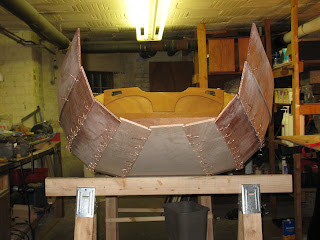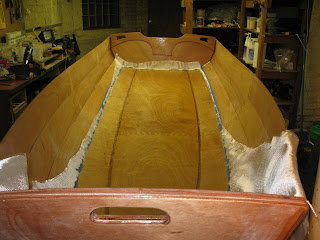When I unpacked the kit, the panels seemed very thin, I was surprised that 6 mm was enough. It was hard to put it into perspective unpacking the box, I was thinking oh oh, I spent a lot of money for a toy that will be broken in a season. I can assure you the PMD is no toy. Once you put the seats on you will understand, it really becomes a boat then. Think about a aluminum row boat, they can really take a beating, how thick is the hull? Enough said.
Writing this blog in reverse has its advantages, Today, after the fog lifts I intend to go sailing on Lake Michigan, it is predicted to be 1-2 foot waves with a south wind at 10-15 knots with 20 knot gusts. The PMD can handle this with no trouble. I did however make a few modifications in both construction and rigging. In this post I will cover the modifications to the boat itself.
I added a 12X18 hatch and storage box instead of a deck plate. It has a water resistant seal and the storage box is removable. I think it is water proof but the manufacturer plays it safe with the wording. I will not repeat what has been written in other PMD blogs about installing this. It is straightforward yet care must be taken to measure correctly. I am building a take apart version. When you cut the boat in half you will remove material, changing the measurements for the mast stop plate in relation to the hatch. When you add the gasket you will add distance, in the end it is a wash.
Writing this blog in reverse has its advantages, Today, after the fog lifts I intend to go sailing on Lake Michigan, it is predicted to be 1-2 foot waves with a south wind at 10-15 knots with 20 knot gusts. The PMD can handle this with no trouble. I did however make a few modifications in both construction and rigging. In this post I will cover the modifications to the boat itself.
I added a 12X18 hatch and storage box instead of a deck plate. It has a water resistant seal and the storage box is removable. I think it is water proof but the manufacturer plays it safe with the wording. I will not repeat what has been written in other PMD blogs about installing this. It is straightforward yet care must be taken to measure correctly. I am building a take apart version. When you cut the boat in half you will remove material, changing the measurements for the mast stop plate in relation to the hatch. When you add the gasket you will add distance, in the end it is a wash.
Below, I reinforced the deck for strength and to be able to use a 1" screw size.
Below the shot shows the 18mm mast support with a notch cut out to receive the mahogany deck support. This firmed up the deck and added compression support from top to bottom. Dry fittings are important to get it just right before you epoxy it all together. I would have liked to add a support on the hull to receive the deck supports but at this point, I was not confident where the deck will end up on the hull. As it turned out, locating the deck and gluing it on was a bit of a challenge. I needed to use the trick in the CLC manual with a clamp and stick to hold the deck close the the hull to get it epoxied in place. Great idea CLC!
My next modification was due to my new outboard. Thanks to Al Gore and all his tree hugging friends, two cycle engines are gone, four cycles suck! My engine weighs 55 lbs yet is only 4 hp. A two cycle that weighs 55 lbs would probably be a 10 hp. I really would like to find a 2 or 3 hp used two cycle, perfect for the PMD.
I read in the PMD forum about the guy that damaged his PMD by slamming it into gear at full power, so with a 55lb motor, I decided to beef up the transom a bit. I decided to use two knees instead of one. I also noticed in his pictures that his plywood failed as only the top layer was holding everything together. The weak link is the plywood. In reality, the epoxy in all the fillets sticks to the epoxy of the deck surface and that sticks to the plywood.
I made up two supports to go under the knees just below the deck. I added a compression plate to support the motor all the way down to the bottom panel and ended up with a three sided box. Here is how it looks.
I read in the PMD forum about the guy that damaged his PMD by slamming it into gear at full power, so with a 55lb motor, I decided to beef up the transom a bit. I decided to use two knees instead of one. I also noticed in his pictures that his plywood failed as only the top layer was holding everything together. The weak link is the plywood. In reality, the epoxy in all the fillets sticks to the epoxy of the deck surface and that sticks to the plywood.
I made up two supports to go under the knees just below the deck. I added a compression plate to support the motor all the way down to the bottom panel and ended up with a three sided box. Here is how it looks.
At this point, I drilled a pilot hole thru the knee and deck and into the support. Once I assembled the seat, I added a lag bolt to pass any load to the entire structure rather than rely on the plywood veneer glue to hold my motor on. I did the same thing at the top of the knee drilling into the motor plate.
I changed out the motor plate and used 18mm there too. Using a support box under the seat ended up being a really solid modification and supports the engine weight well. If I had not already spent $1600 on the engine for my zodiac, I would have used a smaller, lighter engine. With only 90lbs of displacement, and VC17, the PMD goes twice as fast at clutch speed than my zodiac did!
This boat moves so easy through the water, if you fart, you speed up! So far, I have only been at speeds just above idle and already I am past the harbor speed limit with NO wake at all. Nice! It will be interesting to get out into the lake and see how it handles more hp. I am not too sure if it will plane yet but I will let you know. Your weight really effects this boat. I find that I will need a tiller extension for the motor. With only one person, you have to be in the center seat. With two people, you can sit fore and aft just fine.
I put the cutout from the deck hatch in between temporarily so you can see how it works and as my dry fit. I also added a mahogany brace to help support the seat on the transom.
I put the cutout from the deck hatch in between temporarily so you can see how it works and as my dry fit. I also added a mahogany brace to help support the seat on the transom.












































